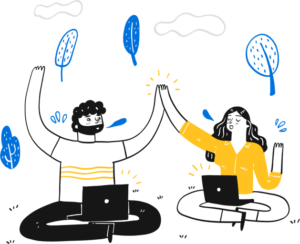The choices we must make | How multiple choice simulations help us learn
April 21, 2022 2022-09-13 15:31The choices we must make | How multiple choice simulations help us learn
The choices we must make | How multiple choice simulations help us learn

We spoke to our in-house instructional designers and behavioral psychologists to uncover how exactly the various options in games or simulations help us master different behavioral skills. Is it just about finding the right answer, or is there something more?
To understand this in more detail, let’s look at an example. Imagine you are playing a simulation and are met with the following situation:
Your team member has submitted a report with a lot of errors. How will you give her feedback on the same?
- This is terrible. How could you be so careless?
- I know you tried your best, but it just wasn’t good enough. Let’s try and do better next time.
- Unfortunately, the report had a lot of issues. Can you help me understand why?
- You made a mistake, but that’s alright. It happens. I’m sure you will be more careful next time.
- There were a lot of issues in the report. How do you think you can do better next time?
According to our experts, each of the options listed here (and the associated feedback you receive) has its own unique learning superpower. Becoming aware of these superpowers can help you make the most of your learning experience.
A. The Eliminated Option
“This is terrible! How could you be so careless?”
The Eliminated option is usually one of the first to be discarded, when making a decision. It is something that we know in theory, should not be said, although we may occasionally do so in practice. This option is sometimes an exaggerated version of our initial emotion-driven responses.
Learning Superpower
The Eliminated option helps you learn by showing you that there are better alternatives out there. It allows for a moment of quiet reflection to see how unhelpful these responses can be and encourages you to try something new. When you come across an Eliminated option, make a mental note to stay away from the same, even back at work.
B. The Confusing Option
“I know you tried your best, but it just wasn’t good enough. Let’s try and do better next time.”
The Confusing option usually feels like the right one. It is well-structured, clear and polite. It is likely to be something that we would say in the real world, and hope for a positive outcome. However, somehow, it does not work out the way we planned.
For instance, in the example, although the option seems like the right thing to say, it does not provide the team member with any direction and so is unlikely to lead to changed behavior the next time around.
Learning Superpower
The Confusing option helps bust common myths and misconceptions related to the concept being covered. When chosen, it shows the possible consequences of the option and explains to the learner why it is not the best way forward.
Don’t worry if you chose the Confusing option by mistake. It provides a clear ‘aha’ moment and shows you what you need to actively change or work upon, when back at work.
C. The Almost There Option
“Unfortunately, the report had a lot of issues. Can you help me understand why?”
The Almost There option tends to be a good one. It is likely to result in a favorable outcome. Although there is nothing wrong with it, there is definitely scope to do even better.
For example, let’s look at our original situation. The Almost There option will help the team member reflect on what went wrong, but is there a way we can ensure that the same issue does not arise again?
Learning Superpower
The Almost There option helps you move from good to great. It shows you what can be done to get a more favorable outcome. If you find yourself choosing the Almost There response, stop and congratulate yourself on understanding the concept well. Then, focus on figuring out how you can do even better and take your skills to the next level.
D. The Socially Desirable Option
“You made a mistake, but that’s alright. It happens. I’m sure you will be more careful next time.”
This is the option that people assume the game-makers want you to choose – the perfect or ideal response that is good for games, but you know is not practical in the real-world. It tends to overly favor one person or perspective, while ignoring others, thereby giving you a not-so-effective outcome.
For example, in our feedback situation, this option sympathizes with the team member and is likely to make her feel better about her mistake. However, it in no way helps improve her performance next time, and so may not be the most practical choice.
Learning Superpower
The Socially Desirable option helps you recognize that balance is key, in any situation. It encourages you to look for practical, feasible, win-win solutions for all involved, rather than giving in and sacrificing your own needs.
If you find yourself looking for the Socially Desirable option, remember that you want an option that is most likely to give the best results in the real-world, not just the one that sounds the best.
(Note to game-makers: The Socially Desirable option is a great way to show the legitimacy of your simulation. Once people realize that the best outcomes come from practical solutions, rather than fictious ideals, they are more likely to look at the whole simulation as a relevant, realistic learning experience.)
E. The Most Appropriate Option
“There were a lot of issues in the report. How do you think you can do better next time?”
This option is the one that will get you the highest possible score or the best possible outcome, in the situation. It is likely to be the most balanced and the most practical. In our example, this option calls out the issues with the report, while taking a future-focused approach to ensure that it is not repeated.
Learning Superpower
Interestingly, most learners report that beyond positive validation, the Most Appropriate option does not do much. However, when constructed well, this option has the potential to significantly elevate the entire learning experience. The feedback received when this is chosen provides pro tips and suggestions on how you can apply similar responses back in the workplace. It also calls out specific challenges that you may face in the process and highlights ways of overcoming the same.
So, how does one make use of this information to learn better?
When met with choices in a simulation, do not just look for the Most Appropriate option. Read through and reflect on each one. If possible (if your scores are not being tracked for competitive reasons or if you have multiple attempts), try out each of the options and observe the consequences that follow. It is a safe environment for you to explore different approaches that you wouldn’t be able to back at work, and see which one works best.
Related Posts
Flow in Learning
Experience Flogames
Search
Latest Posts









